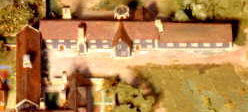|
the hospitium
|
|
|
|
The hospitium or guest house of the Abbey, where
visitors received hospitality, stood where now the Town Hall stands, with
its sleeping rooms stretching eastwards towards the Forbury. The existing
building to the east of the Town Hall stands on the foundations of the
original hospitium building with some of the original stone and brick in its walls.
Mediaeval writers have given us lively accounts of what it was like to be a pilgrim. In the best known a motley gathering sets out on horseback to travel to the shrine of a saint: a nun, a friar, a knight, a cook, a housewife, some two dozen altogether. They get on together not too badly, telling stories as they go and stopping overnight at way-side inns. These are Chaucer's pilgrims on their way to Canterbury, to the shrine of Thomas Becket, but they could have been a party on its way to Reading to the shrine of the Hand of St James. Chaucer's pilgrims set out in a holiday mood inspired by the start of the summer weather, the sweet showers of April and the time when 'smale fowles maken melodye'. Pilgrimage in mediaeval fife was the nearest thing to our package holidays. The Holy Land and Rome were the primary centres; after that the journey to Santiago de Compostela by the coast in northern Spain was the most popular. Here the body of St James the Apostle was entombed and pilgrims to his shrine gathered shells from the nearby beach as a sign of their visit. These shells became the emblem of pilgrimage all over Europe. But there wore two deeper reasons for pilgrimage. One was to gain an indulgence or as a penance for past sins. The other was in search of health, as pilgrims travel nowadays for healing to Lourdes. Miracles of release from disease came from touching the Holy Relics at shrines. The chief Relic at Reading was the Hand of St James the Apostle, separated from the body in Spain, given by the Abbey's founder Henry 1, which led to the coat of arms of the Abbey including the shells of pilgrimage. The Hand was highly regarded not only by pilgrims but also by royalty. It was brought to Henry 11 before his departure on a difficult overseas campaign and Richard Coeur-do-Lion considered taking it on crusade with him. Reading also had many other relics. A document listing some 200 of these survives: part of Moses's rod, manna from Mount Sinai, a fragment of the Cross, one of St Luke's teeth, the skull of St Philip ... Pilgrims arriving at the Abbey were welcomed into the Hospitium of St John the Baptist by the monks in charge, the Hospitaller and his helpers. This building stood where the present Old Town Hall complex now stands to the north of St Laurence's Church. It provided hospitality rather than medical care. There were dining and reception rooms facing where the modern Blagrave Street runs and a domitory block at right angles running into the Forbury and able to sleep perhaps 400 people. As at all monasteries, free hospitality was offered by Reading Abbey to its visitors, board and lodging for two nights and days after which payment was expected. The problems of administration and feeding these numbers of people were great but were offset by gifts at the shrines in the church. The first Hospitium proved to be too small and was rebuilt on a larger scale in 1189. A night in the dormitory amongst the pilgrims from all walks of mediaeval society, not to mention the bed-bugs and other insect parasites which thrived on the visitors, would be a most enlightening experience for us if we could travel back in time. After enrolling at the Hospitium the pilgrims crossed the open area of the Forbury in front of the west door of the Church to enter through it into the nave and to the shrines set around the walls. The Relics were kept at the shrines in Reliquaries, boxes in gold and silver and jewelry reflecting the holiness of the saint from whom they came. The Hand of St James may have been contained in a Reliquary in the shape of a hand and was probably kept in a place of eminence behind the High Altar. The usual method of showing devotion was the purchase and lighting of a candle at a shrine and a suitable gift, usually money, was given as a thank offering for a cure. Some pilgrims were in a pitiable state of health or carrying a weight of guilt and the monks at the shrines ministered to them as best they could. Some accounts of miracles of healing from the Hand have come down to us and you can read about them in the articles by Brian Kemp:- Kemp B R 1970, The miracles of the Hand of St James, Berkshire Archaeological Journal , 65, 1 - 19. Kemp, B R 1990, The hand of St James at Reading Abbey, Reading Mediaeval Studies, 16, 77 - 96, University of Reading. |
|
Copyright Reading Museum Service from "Reading Abbey", published by Reading Museum & Art Gallery 1988. click to return to Discovering Reading Abbey |
